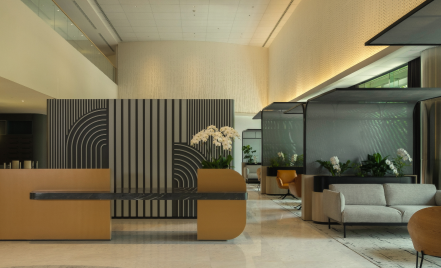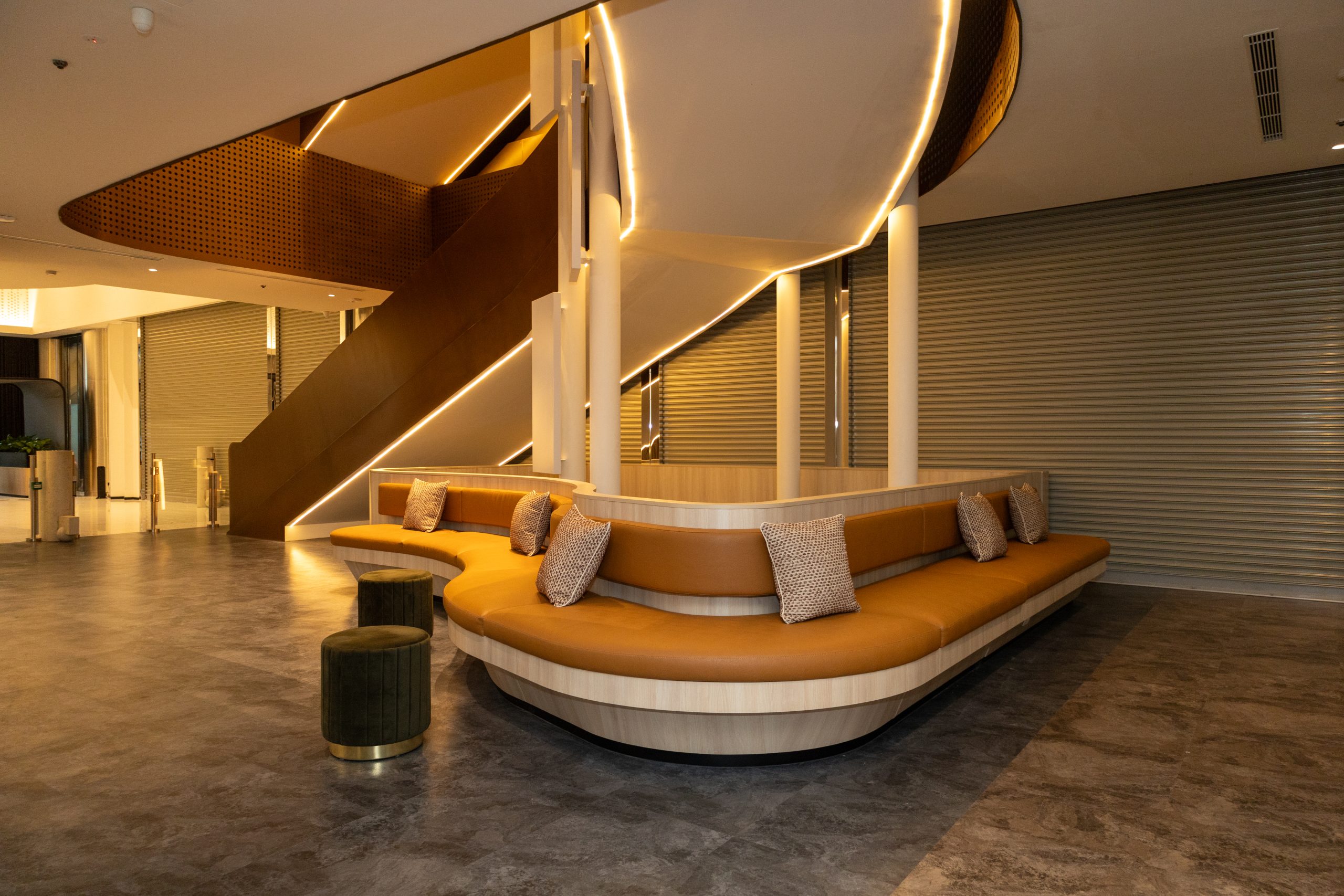In today’s fast-paced work environment, how office space affects productivity is a critical factor that influences employee performance and the overall success of a company. A well-designed workspace can enhance productivity by creating an atmosphere that fosters focus, efficiency, and motivation. Conversely, an uncomfortable office with numerous distractions or inadequate facilities can diminish employee morale and hinder performance.
When employees are in an environment that prioritizes their well-being—one that promotes collaboration, reduces stress, and boosts concentration—they are more likely to be productive and engaged in their tasks. Every element, from the layout of the office to ergonomic furniture and proper lighting, plays a vital role in creating a positive work experience.
This article will explore why it is essential to create a workspace that supports your team and why office space is important for contributing to the overall success of a business.
The Link Between Office Space and Productivity
How does office space affect productivity? The work environment plays a significant role in shaping how employees perform, both in terms of productivity and mood. A well-designed office is not just about having a beautiful view; it’s about creating a space that supports focus, creativity, and job satisfaction.
Our brains respond to stimuli from our surroundings, and factors such as lighting, sound, and color can significantly impact productivity. For example, employees working in spaces with natural light and outdoor views report up to an 18% increase in productivity.
Factors That Influence Productivity Through Office Design
Lighting plays a crucial role in productivity. Natural light can boost mood and energy levels, while good artificial lighting helps reduce eye strain. Research from Cornell University shows that natural lighting in the office can improve employee well-being.
Acoustic management is equally important to maintain focus. What is coworking office space and how does it affect the noise levels? Office noise can be disruptive, so incorporating sound-absorbing materials or creating quiet zones can help foster a more productive environment.
The office layout also influences how employees work. A design that facilitates movement and easy communication will support more effective collaboration. Additionally, the color of the workspace can affect both mood and productivity. For example, blue promotes calm and focus, while yellow stimulates creativity.
Key Elements of a Productive Office Space
Creating a productive office space requires careful attention to various design elements that complement one another. Below are key components to consider:
1. Physical Layout and Environment
The layout of the workspace has a significant impact on employee productivity. Open spaces can encourage collaboration and communication among employees, while private offices or cubicles provide an environment conducive to better focus. Providing flexible work areas, such as height-adjustable desks and movable partitions, allows employees to customize their workspaces according to their needs, fostering comfort and efficiency in their work.
2. Noise Management
Noise management is essential for maintaining concentration and reducing stress. Using sound-absorbing materials, creating designated quiet areas, and implementing white noise systems can help minimize distractions. This way, employees can work with focus in an environment that supports productivity while still having spaces for collaboration.
3. Technology Infrastructure
A strong technological infrastructure is crucial to support efficient workflows. Providing up-to-date work devices, reliable internet connections, and integrated software ensures employees can work smoothly and stay connected with colleagues or clients. Investing in adequate technology creates an environment where employees can operate at their best.
4. Collaborative Spaces
Spaces designed for collaboration, such as meeting rooms or discussion areas, are vital for supporting innovation and problem-solving. These areas should be equipped with furniture and tools that facilitate group conversations and team projects. By providing such spaces, companies can foster creativity and enhance team dynamics.
5. Wellness Considerations
Employee well-being directly impacts their productivity. Utilizing ergonomic furniture, ensuring proper lighting, and maintaining air quality in the office are essential for creating a healthy workspace. Additionally, providing amenities such as break rooms, fitness areas, and natural elements like plants can help reduce stress and improve overall job satisfaction.
Common Workplace Distractions That Hurt Productivity
In the workplace, there are several distractions that often hinder focus and employee productivity. Identifying these disruptions is crucial so companies can take steps to minimize their impact and create a more conducive work environment.
1. Excessive Noise
Loud sounds, such as lively conversations or the noise of office equipment, can disrupt concentration and cause stress. A noisy office atmosphere can reduce employees’ ability to focus, making work feel more exhausting and less productive.
2. Interruptions from Colleagues
Frequent interruptions from coworkers, whether through casual chats or unexpected visits, can disrupt workflow. Employees need time to regain focus after each distraction, which can lengthen the time it takes to complete tasks and ultimately lower productivity.
3. Overcrowded Workspaces
A cluttered workspace or one that is overfilled with items can divert attention, make employees feel stressed, and make it difficult to stay focused. A neat and organized workspace is crucial for maintaining comfort and enhancing efficiency.
4. Improper Lighting
Lighting that is too bright or too dim can lead to eye strain, headaches, and cause employees to feel fatigued quickly. Proper lighting is essential to maintain physical comfort and to support sustained focus during work.
5. Uncomfortable Furniture
Non-ergonomic desks and chairs can cause physical discomfort, such as back pain or fatigue. This can disrupt concentration and make employees feel uneasy while working, ultimately impacting their productivity.
Why Private Offices Improve Workplace Productivity
Private offices offer a range of benefits that can significantly enhance productivity in the workplace. One of the primary advantages of private offices is their ability to reduce distractions.
In open-plan office spaces, numerous factors can divert attention, such as conversations between coworkers or background noise. However, having a private office allows individuals to focus more easily and work without interruptions, which naturally contributes to improved work efficiency.
Additionally, private offices provide a higher level of privacy, especially for tasks that require confidentiality. With a closed space, sensitive information can be kept more secure, reducing the risk of data breaches or the exposure of private conversations that could occur in an open setting. This privacy also fosters a sense of security and builds trust between employees and the company.
Private offices also help employees stay more organized and establish a more structured work routine. Without external distractions, individuals can set schedules and prioritize tasks more effectively, creating a more disciplined and productive work rhythm. The freedom to manage time and tasks without feeling pressured by the surrounding environment is a key factor in maintaining focus and achieving higher levels of productivity.
By providing employees with private office services, companies can cultivate a more efficient, secure, and organized workplace that promotes greater productivity and employee satisfaction.
Why Choose Flow’s Private Office Solutions?

Flow offers private office service and solutions designed to enhance workplace productivity and comfort. The private offices provided by Flow offer a tranquil, distraction-free environment, allowing employees to work with greater focus and without interruptions. Additionally, the ergonomic furniture provided supports employee comfort and health, reducing the risk of physical injuries that can arise from using unsuitable office equipment.
The facilities are also modern and fully equipped, with high-speed internet and meeting rooms furnished with advanced technology that supports smooth business operations. This helps businesses run more efficiently and effectively.
Another key advantage of Flow is the flexible leasing options. Flow allows companies to tailor office space according to their needs, enabling them to add or reduce space as the business grows. This makes Flow not only a comfortable and productive choice but also a cost-effective solution that can be adapted to a company’s evolving requirements.
Conclusion
A well-designed office environment plays a crucial role in boosting employee productivity. By creating a workspace that supports comfort, focus, and well-being, companies can experience significant performance improvements, ultimately contributing to sustainable business growth.
To achieve an optimal workspace, consider exploring Flow’s private office solutions. Flow offers a distraction-free environment designed to enhance employee efficiency and comfort. With modern facilities and flexible options for space customization, Flow is the ideal choice for companies looking to boost productivity and team performance.
Flow is a premium coworking office space located in the heart of Jakarta, inside Midplaza and just steps away from the Setiabudi MRT Station. Featuring world-class design with a five-star hospitality touch from AYANA, Flow provides spacious workspaces, a stylish café, and bright, peaceful private offices—perfect for professionals seeking a quality workspace.
To learn more and find an office space that fits your business needs, visit: Flow!


